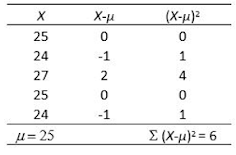📌 Chi-square distribution
If Z is
a random variable with a standardized normal distribution (mean zero and
variance 1), then Z2 has a chi-square distribution
with 1 degree of freedom.
Z ∩ N (0,1)
Þ Z2
∩ c2 (1df)
If Z1, Z2,
……, Zk, are a set of independent and identically
distributed standard normal variables, then the sum of their squares has a
chi-square distribution with k degrees of freedom.
Let Xi be k independent and normally distributed random variables with mean µ and variance σ2
1. Then (Xi - µ), i from
1 to k, has mean zero and Σ (Xi - µ)2 has a chi-square distribution with k degrees
of freedom.
🤯 EXAMPLE
In a
city where police officers rely on speed radars that require regular
calibration, a specialized center ensures that these devices operate correctly.
Experts at the center have established that, in an urban area, radar speed
readings (Xi) follow a normal distribution with a mean of 25
mph and a standard deviation of 3 mph:
· Mean: μ = 25 mph
· Standard
deviation: σ = 3 mph
The
manager of the center is considering purchasing new radars and has received
proposals from two manufacturers. Both manufacturers claim that their radars
produce speed readings that are normally distributed with a mean of 25 mph and
a standard deviation of 1 mph.
🛑 Testing the First
Manufacturer
To test
the first manufacturer's claim, the manager instructs a technician to take five
speed measurements using a test car programmed to travel exactly at 25 mph. The
recorded speeds are:
25,
24, 27, 25, 24
At a
significance level of α = 10%, the null hypothesis is H0: σ = 1 (the
radar's standard deviation is 1 mph, as claimed.).
To test
this claim, we calculate the variance:
The sum
of squared deviations from the mean, ∑ (Xi − μ)2 = 6. For a significance test at α = 10%
with 5 degrees of freedom, the chi-square critical values are obtained. The
calculated chi-square value of 6 falls within the acceptance region.
The critical t-value at α = 10% and 4 degrees of freedom is 1.533.
Since 6.67 is far beyond the critical z-value, we reject H0. This confirms that the second radar is not correctly calibrated, as its mean is significantly different from 25 mph.
✅ Final Decision
·
The first
manufacturer's radar passes the variance test and seems to be properly
calibrated.
·
The second
manufacturer's radar fails both the variance and mean tests, indicating a
significant calibration error.
Recommendation: The center should accept the first manufacturer's radar and reject the second one due to its inaccuracy in measuring speed correctly.










No comments:
Post a Comment